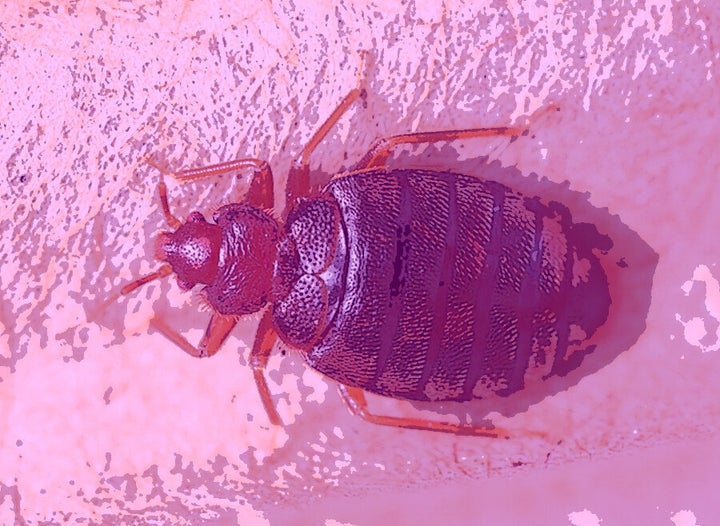
Bedbugs are thriving this summer, according to figures from a nationwide pest control company shared exclusively with HuffPost UK, which revealed a 28% increase in bedbug enquiries between May and June this year.
It comes after British homes faced more bedbug infestations than usual in 2018, because of the hotter summer temperatures.
David Cross, head of technical training academy for Rentokil Pest Control, which has experts based throughout the UK, says he’s witnessed a rise in bedbugs over a number of years now – and has dealt with infestations in care homes, hotels, planes and buses.
So why are they on the rise – and what can we do about them?
Why Are Bedbugs On The Rise?
There are two main reasons for the rise in enquiries between May and June this year, Cross suggests.
Firstly, bedbug eggs require warmer temperatures to hatch – and we’ve had some scorching days this year – and secondly, people are moving about a lot more, staying in different hotels or travelling to new places, meaning there’s a greater chance of bringing bedbugs home.
The bugs can easily cadge a lift on your luggage and clothes or, if you buy secondhand furniture, they’ll hop on that too.
Where Will You Find Them?
Bedbugs are about the size of an apple pip and dark brown in colour. If they’ve had a feed, they might be dark red. Their ideal environment is somewhere warm and where they can eat.
“Normally when we’re doing surveys on properties, the place we find bedbugs most often is around the head of the bed,” says Cross. “The reason for that is they’re very close to the meal.”
But it’s not always the headboard, he notes. In heavy infestations, bedbugs can spread throughout the house and be found in the cracks of skirting boards, on walls, armchairs, behind bedside cabinets, under televisions and even tucked away in the seams of curtains.
So why are they found so far apart? “They have a bizarre means of reproduction where the male will stab the female through the abdomen with its penis when it mates, which is quite traumatic,” claims Cross. “And it can actually injure and even kill the female.”
Once she’s mated, the female will prefer to move away from the males, he says – “So what happens is heavy infestations tend to spread away from the headboard.”
How To Tell You Have A Problem
Keep an eye out for the bugs themselves or look for any tiny blood spots on your sheet or mattress, suggests Natalie Bungay, technical officer for the British Pest Control Association – who adds that she hasn’t witnessed a rise in enquiries regarding bedbugs this year.
Bedbug droppings are also a telltale sign you have a problem, which she describes as looking “like a fountain pen has been dotted on paper”. These droppings will often be smeared onto fabric, mattresses or headboards.
You might also have bites on your body from where they’ve fed. Initially, says Cross, you won’t know you’ve been bitten. But after a few times, you might get a lump which is quite itchy. “Bedbug bites generally don’t have a tip,” Bungay explains. “Sometimes when you’re bitten by a mosquito you have a white tip on top of the bite, but with bedbugs it tends to be a smooth, red lump.”
Cross says it can be hard to tell if you have a bedbug infestation, so it’s wise to keep an eye out for a combination of bites, blood marks on bed clothes and spotting around the mattress or headboard.
“The place where we find bedbugs most often is around the head of the bed.”
How To Get Rid Of Them
If you do discover bedbugs or you suspect you might have them, call a pest controller. “There is not much you can do,” Bungay explains. Even if you see one bug on its own, the likelihood is that there will be far more hidden away.
Typically, a pest controller will come and inspect the rooms where the bugs have been found, as well as nearby rooms. This, Bungay says, can take up to three hours. “They will then come up with a treatment plan,” she adds. “This usually involves some form of insecticide.” The disadvantage of chemicals is that you can’t go back into the room(s) for a period of time afterwards.
You may pay a small fee – around £35 – for an inspection without treatment, then prices vary, but on average start from around £150 for a treatment.
Quite often pest controllers use a mixture of methods to attack the problem, rather than just spraying an insecticide. They might also use heat, because heating furniture to more than 55 degrees celsius has been found to kill the bugs and their eggs. Cross explains they use a “compact heat pod” to heat the furniture up to a high temperature, ensuring it stays at that temperature for a period of time, therefore killing any creatures that might be dwelling there. “When it comes to harbourage behind skirting boards it’s a bit more difficult,” he admits.
If your mattress is covered in bedbugs, it might have to be removed from your home – and you can’t get a new one until the infestation has been removed, otherwise they’ll simply re-infest the new one.
Freezing things, such as bedsheets and shoes, can also help kill them. “Stick them in the freezer for 48 hours,” Bungay explains. “Insecticide doesn’t penetrate their eggs whereas cold and heat kills every life stage.” However, it’s highly unlikely you’ll get rid of bedbugs completely by freezing only.
For more information on bedbug bites and how to treat them, visit the NHS website.